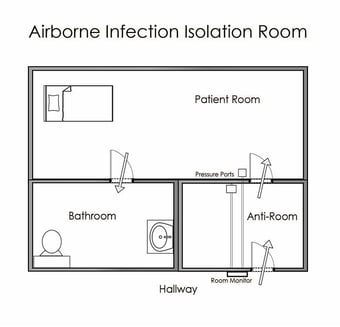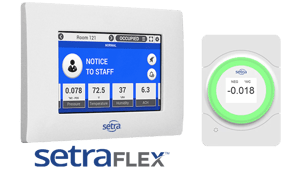In the wake of the coronavirus, it is imperative for hospitals to be prepared for future outbreaks of infectious diseases. For these situations, the safest method for treating patients is isolation rooms. The safety and effectiveness of such rooms is contingent upon proper control of the room's differential pressure.
What are Isolation Rooms?
Isolation rooms are single occupant hospital rooms designed to prevent contaminated particles from spreading beyond a quarantined area. To prevent pathogens from escaping, isolation rooms require negative air pressure relative to the outside area. Negative air pressure means clean air is pulled into the room and contaminated particles cannot leave. The air is then exhausted through dedicated ductwork and a HEPA filter instead of being recirculated through the main HVAC system. Incorrect room pressurization can put patients and staff at risk of exposure if contaminants escape the space.
Maintaining the Safety of Isolation Rooms
The most resourceful way to implement an isolation room strategy is to employ a room pressure monitor's (RPM) real-time monitoring and alarm capabilities. RPMs are the safest and most reliable monitoring solution for isolation rooms. Some RPMs even have the ability to monitor temperature and humidity.
A room pressure monitor produces both audible and visual alarms as well as connect to a building management system. When a room is compromised, the alarms sound, reducing the labor necessary to manually certify negative pressure. This minimizes the possibility of a catastrophic oversight.
Ensure Safety with Setra's RPMs
Setra has engineered technology to protect patients and staff, especially those in isolation rooms. Setra FLEX and Setra Lite can help prevent airborne infections like the coronavirus from spreading.
 For the isolation rooms, the most effective way to monitor room pressure conditions is with a monitor that can support multiple rooms, like Setra FLEX. In addition to monitoring room pressure, FLEX displays measurements for temperature, humidity and air changes per hour. Controllable through a BMS or over a network via BACnet, Setra FLEX can help guarantee the safety of a critical space.
For the isolation rooms, the most effective way to monitor room pressure conditions is with a monitor that can support multiple rooms, like Setra FLEX. In addition to monitoring room pressure, FLEX displays measurements for temperature, humidity and air changes per hour. Controllable through a BMS or over a network via BACnet, Setra FLEX can help guarantee the safety of a critical space.
Setra Lite can replace outdated and unreliable measurement devices like a ball pressure indicator. using Setra's dead-ended capacitive transducers, Lite allows staff to see at a glance if a room is properly pressurized, even from down the hall. Lite's analog output can be directly connected to a BMS or Setra FLEX to indicate when a room goes into alarm.



